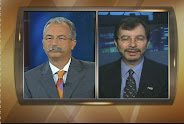Ben Opens The Kimono
If one took the time to sit and listen carefully, the Bernanke press conference was an excellent opportunity to understand not only the decisions made but the economic philosophy underlying them. For that, Bernanke should be applauded. Transparency is almost always a good thing.
You don’t have to agree with the decisions made. However, knowing the thought process that leads to the decisions will help much more than whether his voice sounded shaky (which, if you listen to his testimony to Congress, it always does) or if he appeared to be sitting behind a piano (I actually love that comment. The imagery of Ben crooning a tune is priceless. Thanks, to Matt Phillips at WSJ).
In a manner similar to what St. Louis Fed President James Bullard discussed at the NYSSA luncheon I moderated last fall, Bernanke lays out the thinking behind the decisions. Therefore, here are a few observations:
• First quarter slowdown is transitory. Economic pace will pick up over time. Accordingly, the US economy should achieve a sustainable expansion. Continued improvement is expected. (Key words "over time". Lots of wiggle room.)
• Concern re inflation and its impact on jobs. Inflation (and any deviation away from stable, low inflation, which, of course includes deflation, for that matter) will inhibit job growth and must be guarded against.
• Related to this is the issue of long-term unemployment, which the Fed can virtually nothing about beyond seeking to help the current conditions and, thereby, help facilitate a virtuous circle of jobs creation. The long-term unemployment problem is one for the political process and other areas of the US economy.
• The Fed holds a “stock view”, which is actually Soros' "Reflexivity" – the feedback loop from the financial markets to the real economy and back and forth over and over. In this regard, QE (1 and 2) worked because “easing financial conditions leads to better economic conditions.” This is exactly the same philosophy and view expressed by St. Louis Fed President James Bullard at the New York Society of Security Analysts luncheon I moderated last fall.
• As for the potential of more QE, Mr. Bernanke took that off the table when he noted that in the Fed’s view the tradeoffs of more easing versus the risks of inflation and inflationary expectations are not favorable. (Perhaps for the reasons John Hussman has been fretting about.)
• Fiscal cuts (austerity) at the state and local level are not a major concern and, therefore, no plans to respond monetarily. The Fed is ready to react but no worries right now. (Not sure how this squares with the previous point.)
• The first step that signaled the end of monetary easing is occurring at the end of June, when QE2 ends. The second step that will signal the end of Fed easing is when the Fed stops reinvesting the US Treasuries and the mortgage back securities it has on its bloated balance sheet. This will, in effect, lower the size of its balance sheet.
• Rogoff and Reinhardt have shown that recoveries following financial crises tend to be slower and less robust. Bernanke believes this is true, as the problems tend to be in the credit markets and housing. He also, believes, however, that the reason for the post credit crises below average recoveries is that policy responses were not adequate. In his and the Fed’s board view, the aggressive and extraordinary actions undertaken by the Fed should help lead to a better economic outcome for the US. That said, he did acknowledge that the US economy growth (and employment, for that matter) thus far has been sub par but, as noted above, the Fed expects “recovery continues to be moderate but the pace will pick up over time.”
So what can we take away from this press conference that is of meaningful investment value? Two main items come to mind:
1 – The Fed is driven to maintain stability at the price level. They are very concerned about inflation (for the employment related reasons noted above). They are, however, deathly afraid of deflation. A Goldilocks approach to inflation is the only porridge that will do. And that is a very difficult thing to accomplish indefinitely.
2 – In the current environment and now that, in the Fed's view, the deflationary dragon has been slain, inflation and job creation are joined at the hip. Rising inflation will impact job creation and must be avoided at all costs.
Everything described above assumes an private sector led sustainable economic expansion lies ahead, which takes us to my third and most important point:
3 - No one asked the one question that I would have asked (and the one I have been asking for months now), What if the US economy does not achieve the escape velocity of a private sector led sustainable economic expansion?
What will the Fed do? What can the Fed do?
How will the markets, the economy (US and global), the geo and socio political environment react to another round of monetary easing? Why would QE 3, 4, or 5 work when 1 and 2 produced such transitory (and some would argue negative) effects?
If the Fed is right and a private sector led sustainable economic expansion does emerge, then the outlook will improve but to what extent remains to be seen. If not, then what?
Is there a plan B? A plan C?
Bottom line: What Bernanke did is a terrific thing. Transparency is almost always an excellent thing. Moreover, I truly believe he is sincere, knowledgeable, hard working, and has little in the way of political agenda (unlike Geithner). That said, being a good guy is not enough if the actions taken lead to a bad outcome.
Herbert Hoover was a good guy and look at how that turned out.

























